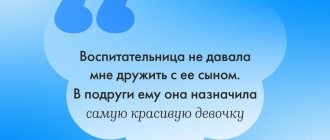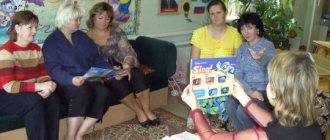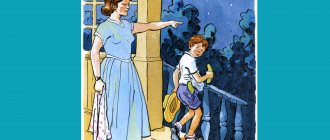Program “Interaction with parents in accordance with the Federal State Educational Standard”
- Social anemnesis of the family.
- Drawing up and filling out a socio-demographic family passport.
- Questionnaire to identify the level of teaching capabilities of parents.
- Analysis of socio-pedagogical factors in family education of children.
- Analysis of types of families of pupils.
- Determination of parenting styles in the family.
- Determining the pedagogical competence of parents Priority activities with teachers:
- Questionnaire for educators “My pros and cons” in communicating with parents.
- Test surveys of teachers.
- Self-analysis of the behavior of a collective meeting with parents. Methods of involving parents in the activities of preschool educational institutions:
Stage I: updating the needs of parents in the field of education of their own child. Stage II: pedagogical education of parents as customers for educational services in preschool educational institutions. Stage III: partnership between teachers and parents in the activities of preschool educational institutions, which is based on the ideas of humanizing relationships, the priority of universal human values with an emphasis on a personal-active approach. The implementation of the program allows you to meet the needs of parents;
- in providing a unified system of work on gender-role socialization of a preschooler, which contributes to the development of the child’s personal potential;
- in increasing the authority of the preschool educational institution among parents; The implementation of the program promotes the inclusion of parents in the educational process (involving parents in holding joint holidays, meetings with interesting people, enriching the subject-development environment); – family participation in the implementation of the program contributes to the creation of a favorable, emotionally comfortable environment in groups, reduces children's anxiety, increases the self-esteem of pupils, and allows for an individual approach in raising boys and girls. The implementation of the program allows you to satisfy the needs of a child of senior preschool age - for full development as an individual, helps to enter the modern world, and become familiar with its values. Conditions have been created for the social and personal development of the child, in which:
- — the child develops a holistic positive view of the world around him and a person’s place in this world;
- — the content of work with children is built taking into account the individual characteristics in the development of boys and girls, built on closer material, so adaptation to society is easier;
- – the child receives skills of adequate and safe behavior in the world around him;
- - children are included in various activities that contribute to the development of knowledge about the world around them and the formation of gender role positions, preparation for family life, a positive attitude towards their gender and health;
- — social experience, experience of communicative interaction with others is enriched;
- – graduates of preschool educational institutions successfully transition to a new life situation and easily adapt to society. The implementation of the program allows us to meet the needs of preschool teachers to improve their professional level and qualifications. Active forms of advanced training (workshops, seminars, methodological associations) contribute to the development of teachers’ skills:
- – in organizing the subject-play space based on the requirements of the program;
- – in implementing consistency in the planning of group teachers, specialist teachers, parents and coordinating their activities within the framework of this topic;
- – in organizing interaction with the families of pupils to ensure continuity in the upbringing, education and development of the child;
- – in increasing the professional rating of preschool teachers in the educational environment of the city. Compiling an information bank on this topic. Identification of the level of activity, psychological and pedagogical culture of parents. (Questionnaire method, observation) 1. Showing parents’ interest in the issue of gender role education. 2. The emergence of dialogues, discussions, questions. 3. The desire, together with teachers, to reflect on the methods and techniques used in education and training on this issue. 4.Increasing the activity of parents: analyzing situations, attending classes, finding a way out of problematic situations. Formation of personal qualities of parents (observation, conversations, participation in various events) 1. Pedagogical competence - the ability to understand the needs of children and create opportunities to satisfy them, make the child happy, the ability to see the prospects for the child’s development. 2. Pedagogical reflection - the ability to analyze one’s own educational activities, critically evaluate them, separate one’s own problems and difficulties from the problems and difficulties of children, and choose methods of influencing the child. 3. Creativity – as creativity in a broad sense, an active life position, the ability to comment on the process and result of one’s own activities. 4. Initiative – manifestation of a desire to get involved in a variety of activities, the ability to propose an interesting event. 5. Responsibility – the ability to see, understand mistakes, correct them and avoid them in the future; desire to carry out the assigned task in accordance with capabilities and competently understand their role in education. 6. Self-esteem – the ability to objectively evaluate the results of one’s activities, one’s educational influence on children, and to defend one’s position. Awareness by parents of a single educational space “Family - kindergarten - school” (participation in events, conversations, observations, questionnaires) 1. Understanding the need for interaction between family and kindergarten with the social environment. 2. The ability to see your place and role in this process. 3. Understanding the need for successful socialization of a child in modern conditions. Availability and dissemination of experience in family education (questionnaire survey, taking into account the participation of parents in various events) 1. Speeches by parents at conferences and seminars. 2. Providing material on family education for the newspaper “Semya”. 3. Participation in competitions, exhibitions, and joint creativity with the child. Specific expected results: At the final stage of introducing the program into the work of the kindergarten, it will provide an opportunity to activate parents, which will contribute to the establishment of a dialogue between the preschool educational institution and the family. This will provide an opportunity to form an active parental position, update acquired knowledge, and help parents look at specific situations through the eyes of their children and understand them. The program will help to understand the attitude of teachers towards cooperation with parents; they will feel the need for constant growth of professional skills, level of self-education, and erudition. The use of non-traditional forms of work with parents will increase the level of parental involvement in the educational process of preschool educational institutions. The implementation of this program will also help to establish warm, friendly relationships between children, teachers, and parents. Thanks to this program, the level of psychological and pedagogical knowledge of parents and parental competence will increase. Socially significant resonance of the program The family is a social institution of education; it ensures the continuity of generations and the socialization of children. In the family, children gain their first experience of understanding the world around them and learn to communicate. Therefore, the priority of supporting family education, psychological and pedagogical support for the family has been and will be relevant throughout the entire development of society. Public involvement in the problems of development and education of the younger generation will increase. Tasks:
PROGRAM for cooperation between kindergarten and parents of pupils “Family”
Training seminar for parents with training elements
“Warning: hyperactive child!”
Tasks:
help parents understand the nature of interaction with a special child;
learning effective ways to interact with it.
training parents in techniques for developing attention, controlling the child’s activity and impulsiveness;
Progress of the lesson
Exercise “Rituals of greeting”
Goal: relieve tension, set the group in a working mood, create an optimistic mood.
Participants greet each other using greeting rituals common to different cultures. Invite the group to form a circle. One of the participants begins the “dating circle”: he steps into the middle and greets the partner standing on the right. Then he walks clockwise and greets all members of the group one by one.
Each time the participant must greet his counterpart with a new gesture. At the same time, he introduces himself, saying his name. In the second round, another participant enters the circle, standing to the right of the first, and so on.
Greeting options:
slight bow, arms and palms extended to the sides (Japan);
hug and three kisses alternately on both cheeks (Russia);
a slight bow with arms crossed on the chest (China);
handshake and kiss on both cheeks (France);
slight bow, palms folded in front of the forehead (India);
kiss on the cheeks, palms resting on the partner’s forearms (Spain);
a simple handshake and eye contact (Germany);
soft handshake with both hands, touching only with fingertips (Malaysia);
rub noses against each other (Eskimo tradition).
Good evening, dear parents. The topic of our meeting, “Hyperactive Children,” was not chosen by chance. The problem of hyperactive children, a problem associated with the so-called attention deficit hyperactivity disorder, has recently become increasingly relevant. Today, you will get acquainted with the concept of hyperactivity, play games that need to be played with such children, and learn to better understand your child.
Mini-lecture “What is hyperactivity.”
“Hyper ...” (from the Greek hyper - “above”, “above”) is a component of complex words, indicating an excess of the norm. The word “active” came into Russian from the Latin “activis” and means “effective, active.” The reasons for the appearance of hyperactivity in a child may be genetic factors, birth injuries, infectious diseases suffered by the child, etc. External manifestations of hyperactivity are inattention, distractibility, impulsiveness, increased physical activity. The famous American psychologist V. Oaklander characterizes these children as follows: “It is difficult for a hyperactive child to sit, he is fussy, moves a lot, spins around, is sometimes excessively talkative, and can be annoying in his manner of behavior. Often he has poor coordination or lack of muscle control. He is clumsy, drops or breaks things, and spills milk. It is difficult for such a child to concentrate his attention, he is easily distracted, often asks many questions, but rarely waits for answers.” It is difficult to establish contact with hyperactive children simply because they are in constant motion: they do not walk, but run, do not sit, but fidget, do not stand, but spin or climb somewhere, do not laugh, but laugh, get down to business or run away without hearing the task to the end. Their attention is distracted, their eyes wander, it is difficult to catch their gaze, it is difficult for them to sit in one place for a long time, to remain silent, and to obey instructions. They create additional difficulties for educators and teachers in their work because they are very active, irritable, hot-tempered and irresponsible. Hyperactive children often touch and drop various objects, push peers, creating conflict situations. They are often offended, but quickly forget about their grievances. Probably every teacher and parent is familiar with this portrait.





